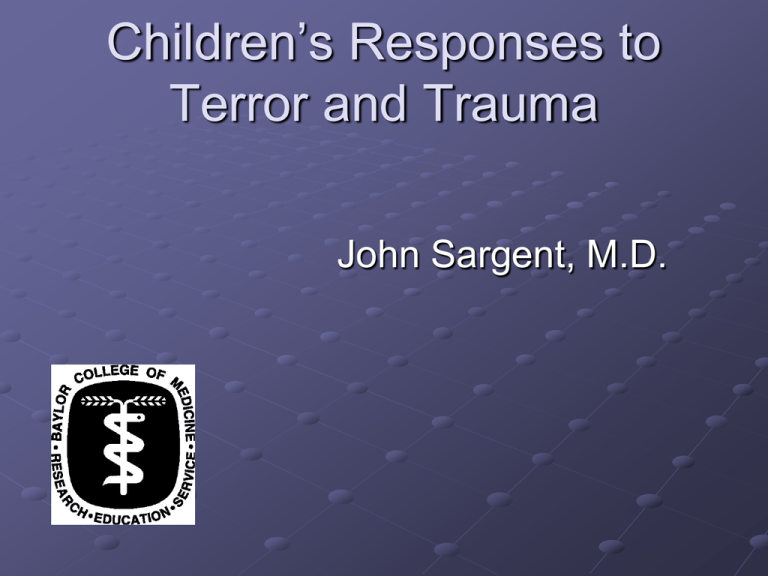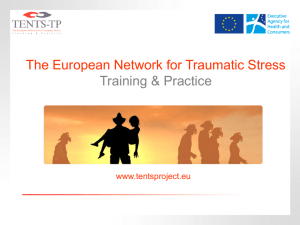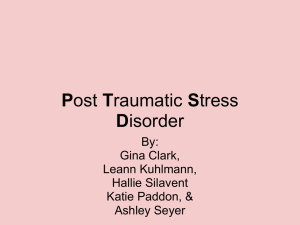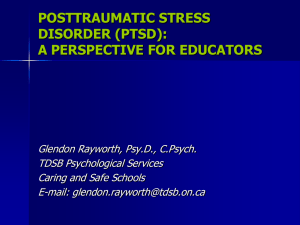Children`s Responses to Terror and Trauma
advertisement

Children’s Responses to Terror and Trauma John Sargent, M.D. Children’s Responses depend upon several variables: Child’s age and developmental status Previous experiences of trauma Family risk and resiliency factors Children’s Responses depend upon several variables (cont): Preexisting attachment relationship Nature of traumatic experience and continuing threat Nature of community and family support Influence of Developmental Stage on Child Responses Preschool children Primary problems are related to separation Refuse to attend preschool Sleeping with parent Whining and clinging behavior with parent Influence of Developmental Stage on Child Responses (cont.) Trouble sleeping and nightmares Reactive aggressiveness Repressive behaviors; bed wetting and fears Influence of Developmental Stage on Child Responses (cont.) School Age Children Attention and concentration problems Anxiety with associated school avoidance, fears and somatic symptoms Sleep problems and nightmares Influence of Developmental Stage on Child Responses (cont.) Angry outbursts Depression and withdrawal Influence of Developmental Stage on Child Responses (cont.) Adolescence Hypervigilance and intrusive thoughts Emotional numbing and nightmares avoidance Influence of Developmental Stage on Child Responses (cont.) Peer and family problems Substance abuse Overt depression Influence of Developmental Stage on Child Responses (cont.) Other affective aspects of trauma/terrorism Humiliation, shame and self-blame Alienation and demoralization Chronic anger and irritability Reexperiencing worsening other symptoms Unique features of Terroristic Events Effects on Children Terroristic events have a profound effect upon adults – including parents and teachers Adult depression may negatively influence children Adults may underestimate effects upon children, especially for distant events Parents’ emotional responses very influential in the children’s reactions Persistent threat worsens children’s exposure and reactions Repeated media viewing also worsens the effects upon children PTSD occurs in 30 – 50% of children exposed to terrorist violence Physical proximity, degree of actual family member involvement and witnessing violence significantly increase risk of developing PTSD 10% of New York City public school students developed PTSD after September 11, 2001. World Trade Center attacks. Disruption, confusion, chaos, uncertainty of events and surrounding events often worsens the situation Rumors, excitement, disorder among helpers can be present at the scene or at hospital or care settings Parental availability and support is highly protective for children (including adolescents) Helpful interventions: Establishing order at the site Ensuring coordinated, cooperative and competent activity among helpers Ensure parents are with children if possible Helpful interventions (cont.): Provide accurate and complete information as soon as available Ensure appropriate medical care Support parents and family care givers especially if child is injured and receiving hospital care Psycho educational supports for families and community networks also are helpful and can lead to rebuilding efforts for the community School based interventions for children can be very helpful: group discussions, resumption of daily routine and structure, gradual expectation of training and competence Dimensions of Assessment Physical well being, differences, acute symptoms and physiologic problems Developmental capacities, variability, deficiencies and areas of regression Nature of trauma and its effects Cognitive capacities including intellectual capacity, specific areas of learning disability and ability to utilize cognitive capacity to understand trauma • Psychiatric symptoms and diagnostic considerations including: Acute Stress Reaction PTSD Depression Substance Abuse Eating Disorders Complex PTSD Conduct Disorder, etc. Assessment of Context: family relationships and interaction, community connectedness, community institutions and rituals Areas of Risk and Resilience: family risk, poverty, social discrepancies, individual strengths, skills and competencies, family and community connection and support. • Other important issues: Cultural background Ethnicity Cultural stories of adversity and survival Belief systems about trauma recovery Peer relationships Current functioning academic family social community (especially in relation to expected development) Stage I: Stabilization Develop a collaborative team with planned, coordinated responses to traumatic events that are competent, compassionate and caring Parents will need to be invited to be members of the team with defined and important roles Swiftly end traumatic events and define all future responses as courageous healing efforts (no matter how disruptive or painful) Treatment is based upon building a relationship of connection and trust, recognizing the experience of shock, anxiety and arousal in the child and family Ensuring physical and psychological comfort produces the possibility of focused attention so that information about plans, procedures and treatment can be shared with and gained by child and family Predictability, clarity, integrity and competence follow the explanations to reinforce trust and collaboration Be prepared to operate on limited, incomplete and often disguised information, focusing upon what is known and what is required by the situation Do not expect that a one time large scale debriefing or counseling effort will produce large scale recovery - in fact “Critical Incident Debriefing” often worsens individual psychological responses Stage II: Restoration Identify key issues which require attention to reestablish continuity of life for children and their family: Housing - Living situation - Care-taking relationships Centrality of Parental Figures (if possible) Financial resources to ensure family continuity Building competence through encouragement and active reinforcement of rehabilitation activities Recognizing grieving as an important activity Identify appropriate anger and begin discussions of accountability Resume, whenever possible, developmentally appropriate activities with parental encouragement (which reinforces parenting role) At this point a comprehensive assessment highlighting individual risk and resilience factors, attention to psychiatric symptoms, and specifics of traumatic experience and emotional reactions is essential and points to appropriate interventions These interventions further reinforce the relationship between the family and the healing system and further support future collaboration This leads to increasing clarity about what has changed, been lost and must be grieved for as well as what new competencies have emerged and must be integrated Build to a recognition of an integrated appreciation of a transformed child and family Stage III: Recovery This stage focuses directly upon attention to significant psychiatric symptoms and syndromes This requires integrated therapeutic responses Exposure and response prevention directly addresses PTSD symptoms (e.g. Foa’s treatment for rape victims) Family therapy leads to greater organization, more parental effectiveness and improved social support Attachment focused psychodynamic psychotherapy enhances mentalization, reduces interpersonal objectification and enhances empathy Cognitive - behavioral therapy addresses depressed mood, inappropriate attributions of helplessness and shame and excessive focus upon retribution and revenge Psychopharmacology to improve mood, increase threshold and decrease amplitude of arousal Behavioral support to decrease avoidance Enhancing physiologic self-awareness to assist in managing and modulating arousal and psychologic self-awareness to appropriately assess danger Work toward the consolidation of a coherent narrative of self, family, community experiences of this trauma that becomes a nuanced, textured memory that can be recalled as a whole and reviewed without reproduction of heightened arousal An orientation toward community and national (if possible) growth through advocacy, truth and reconciliation experiences, memorial and artistic expression Key Issues Competence and connection are antidepressants Information, predictability, intellectual mastery and mentalization manage anxiety, splitting and impulsivity Recognition of what needs to be protected now and of the value of new skills promote consolidation of a transformed self Therapist is vulnerable to burn out, vicarious traumatization and personal experience of vicitimhood Therapists will need to identify the value and meaning of their work while they integrate their awareness of tragic events and of change and growth that reinforces hope











